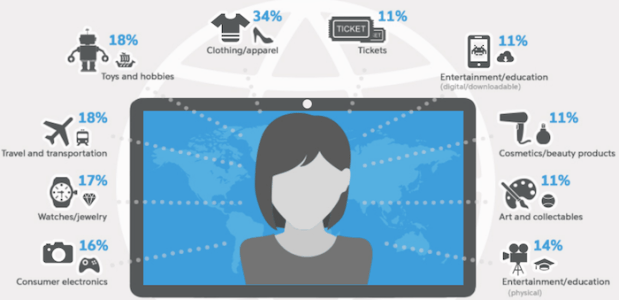Who’s Driving eCommerce Spend?

In the late 90’s there was a popular bumper sticker “Think Globally, Act Locally,” that had all but disappeared by the mid-2000’s when their original owners bought Priuses, which successfully conveyed the same message without the risk to the paint that accompanies a bumper sticker.
That sentiment could stand a post-millennial revision, especially when it comes to commerce, as new data released this week by PayPal and Ipsos reveals. The time might be right for retailers of all stripes to think globally and then act globally.
Why? Cross-border transactions are on the rise, and international shoppers are opening their wallets in a big way, PayPal’s senior director of global initiatives Anuj Nayar told MPD CEO Karen Webster in a recent podcast interview. Nayar explained to Webster that their survey of 17,600 consumers in 22 countries on cross-border shopping showed that such activity is on the rise– which is consistent with the 25 percent increase in such transactions that PayPal has seen over the last ten to twelve consecutive quarter. Access to the internet, which is expected to double between now and 2018, is what’s driving this growth, all thanks to the diffusion of the mobile phone which provides fast and easy access to the World Wide Web.
“Consumers are finally connecting to the internet, and one of the things they are discovering is the value and convenience they can get from shopping through merchants around the world,” Nayar said.
But what their research found genuinely surprising was the revelation that cross-border shoppers (those for whom more than 10 percent of their online spend is cross-border), spend approximately twice as much as consumers who only shop domestically.
“The emerging middle class is eager to take advantage of the opportunities that buying online from merchants in the U.S. or U.K. or Germany will offer to get exactly what they want at a price that is great.”
That said, cross-border buyers still face barriers, Nayar noted, most of which center around shipping (costs or difficulty of), returns and and “lost in translation issues” with websites not in their native language.
For example, Nayar noted, Austria leads the world in cross-border shopping, with 83 percent of their online customers shopping without borders, so to speak. That figure is impressive and even mystifying except when one notes that Austrian consumers shop in “digital Germany,” where they face no language issues. Poland, on the other hand, has one of the lowest rates of international online shopping in the world.
“Geographically they aren’t that different,” observed Nayar, “but from a language point of view you start hitting those inhibitors.”
Webster was interested in digging in further on the inhibitors. She accepts the language barrier as an issue, but noted “there’s the international language of brand and visuals. Prada is Prada, and Valentino is Valentino where ever you go. There must be, though, other things that inhibit purchasing.” She then turned to her favorite topic — payment methods — and asked how they impact consumers and merchants’ approach to cross-border.
“I don’t think you’ll be shocked to find out that the representative from PayPal thinks that this is one of the most important issues. But seriously it is. There‘s 157 million people that have a PayPal digital wallet and when consumers are shopping online there’s a certain level of trust they need to have that everything will go well.”
This is where PayPal believes it has an advantage — they are able to make international transactions easier for consumers because of the trust factor that PayPal has the consumer’s back and can accommodate the method of payment that is convenient and accessible to them.
“There is a level of trust that a U.S. or U.K. consumer has when they’re buying from a small merchant in Thailand, or China or Vietnam that is helped by two things–they have that trust in PayPal and they are paying in their local currency.”
And, of course, every market and every market place are different. Some things are universal or almost universal, according to Nayar. Clothing, apparel and footwear are the leading category of goods for cross-border shoppers everywhere in the world, and consumer electronics usually occupy the second spot.
Unless of course one is in China, in which case cosmetics and beauty products are in the number two seat, and consumer electronics are third.
Also fairly esoteric are the inhibitors of cross-border commerce. While concerns about the cost of shipping and payment are nearly universal, there are also several nation-specific concerns as well.
“In Brazil it’s not the cost of delivery, it’s the delivery time. In Mexico the top concerns are about identity theft and fraud. In Russia the concern is that the items would just disappear and never ever be received. It’s not that it would arrive late or cost too much to ship, it would just disappear.”
Those issues notwithstanding, consumers are ready to open their digital wallets, according to Nayar, which means a big opportunity for merchants ready to meet that need.
“If you’re a merchant who’s not selling cross-border today you are closing off a potential revenue source that can triple, quadruple or grow your business by 10 times,” he stated.
Webster noted that though the opportunity may be there, merchants have to have a way to tap into that opportunity, or as good as it sounds, it’s really not a live possibility, regardless of how potentially lucrative it is. Nayar agreed, but noted that actually whereas even ten years ago jumping onto the international commerce stage was problematic, many third party operators have emerged to make it fairly simple to sell world-wide. eBay, he noted, is such a platform.
He also noted PayPal is doing more to help merchants seize this opportunity. PayPal has launched its PassPort site so it is easy for merchants to know how to leverage the cross-border sales opportunity.
“The idea to tell them (business owners) that there is a business opportunity doesn’t really help them when they are putting in 80 to 90 hour work weeks already. What they want is somebody to give them actionable advice so they can turn an investment of 15-20 minutes reading on the internet into something they can use.”
Making this more actionable, Nayar said, may also just be about looking at the calendar. The world’s shockingly diverse holiday calendar is full of opportunities for merchants to adapt their goods to a global audience ready to buy. For example, Mexico recently wrapped up its answer to Black Friday, El Buen Fin, and summer is revving up in Australia. In February, Brazilians will be shopping for back to school, but if you are worried that might compete with Valentine’s Day promotions in nation, don’t – they celebrate Valentine’s Day in June.
“For US merchants, cross-border sales are an opportunity to sell outside of their in country peaks and to use and re-purpose merchandise they already have,” Nayar notes.
They are also a chance to tap into markets that are so far under-served but on the rise– a situation illustrated nowhere more clearly than in China.
Singles day, notes Nayar, recently brought in $9.3 billion dollars and it hasn’t even gone global yet, though it clearly should.
“I personally can’t believe that this hasn’t become an international Hallmark Holiday already. The idea that you can buy something for yourself and not just celebrate being single but celebrate your individuality and you can go shopping for yourself because there’s a holiday that expects that. Sounds like a brilliant international holiday for me, but right now it’s China only.”
And because it is a China only phenomenon so far, it is an opportunity that many retailers are just missing out on, though that is starting to change, noted Nayar. PayPal created the website Wu Jing Gou (“Borderless Shopping”) to help global merchants from outside China to showcase discounts and deals to Chinese consumers eager to buy something special.
“One of the businesses we worked with, a ski retailer in Beaverton Oregon, saw 110% lift in sales during that 24-hour period around November 11th due to Singles Day. We think there’s many many more opportunities like that.”
In many ways, the situation in China is a good microcosm of the complexity that cross-border buying and selling presents.
Chinese consumers are happy to shop online–as the roaring success of Singles Day demonstrates. However, according to the PayPal Ipsos data, only 26% percent shop cross border. In the past, internet connectivity has been an issue, but that is becoming less of an issue, especially with the rise of mobile. Payment with local payment methods was also a problem, as China Union Pay cards and Alipay accounts work fine in China, but aren’t accepted widely internationally. That too is changing–PayPal has partnered with Union Pay, so that Chinese consumers have an easy way to pay on international merchant sites when using their PayPal accounts, notes Nayar.
“The opportunities get staggering. It’s been ten years since Tom Friedman wrote the book The World Is Flat, and that opportunity that he spoke of is coming to fruition now when it comes to commerce as consumers are able to take advantage of shopping online in markets where they haven’t been before and never had access to.”
The world is getting flatter says Nayar, and though there are still hurdles, none are impossible to overcome, and many are getting easier everyday.
“It’s a lot easier than small business think to take advantage of this opportunity. I mean there’s no reason they couldn’t start even before this holiday season.”
